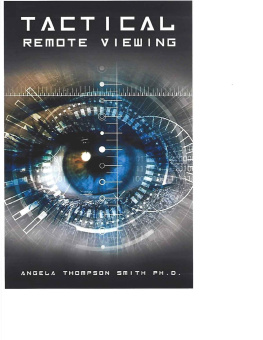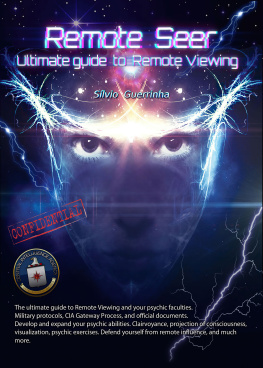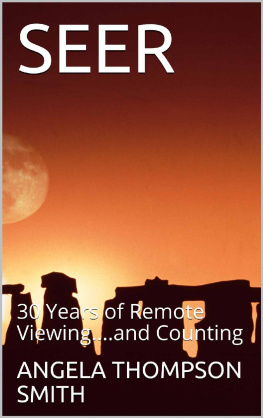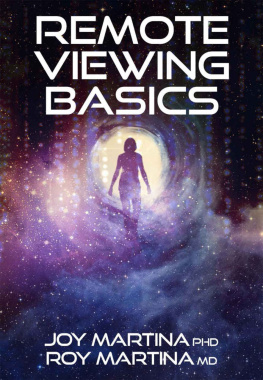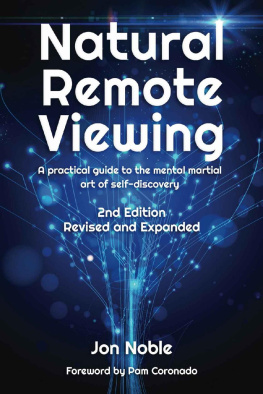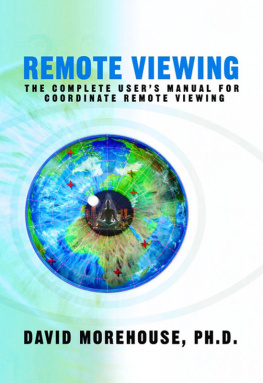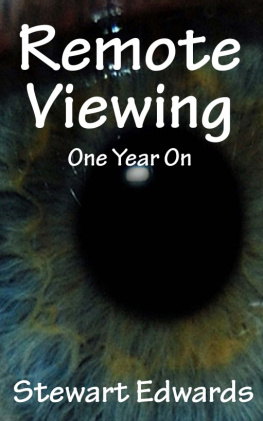Angela Thompson Smith Ph.D - Tactical Remote Viewing
Here you can read online Angela Thompson Smith Ph.D - Tactical Remote Viewing full text of the book (entire story) in english for free. Download pdf and epub, get meaning, cover and reviews about this ebook. year: 2019, publisher: Triangulum Publishing, genre: Science fiction / Religion. Description of the work, (preface) as well as reviews are available. Best literature library LitArk.com created for fans of good reading and offers a wide selection of genres:
Romance novel
Science fiction
Adventure
Detective
Science
History
Home and family
Prose
Art
Politics
Computer
Non-fiction
Religion
Business
Children
Humor
Choose a favorite category and find really read worthwhile books. Enjoy immersion in the world of imagination, feel the emotions of the characters or learn something new for yourself, make an fascinating discovery.
- Book:Tactical Remote Viewing
- Author:
- Publisher:Triangulum Publishing
- Genre:
- Year:2019
- Rating:3 / 5
- Favourites:Add to favourites
- Your mark:
- 60
- 1
- 2
- 3
- 4
- 5
Tactical Remote Viewing: summary, description and annotation
We offer to read an annotation, description, summary or preface (depends on what the author of the book "Tactical Remote Viewing" wrote himself). If you haven't found the necessary information about the book — write in the comments, we will try to find it.
Tactical Remote Viewing — read online for free the complete book (whole text) full work
Below is the text of the book, divided by pages. System saving the place of the last page read, allows you to conveniently read the book "Tactical Remote Viewing" online for free, without having to search again every time where you left off. Put a bookmark, and you can go to the page where you finished reading at any time.
Font size:
Interval:
Bookmark:
TACTICAL REMOTE VIEWING
Angela Thompson Smith Ph.D.
Copyright 2019 by Angela Thompson Smith
All rights reserved. For permission requests contact the publisher, addressed. Attention: Permissions Coordinator at the email below.
Editor: Mindwise Press
(702) 417-6154
First Printing, March 2019
ISBN: 978-1794055223
Cover Design by Daz Smith
Also published by Angela Thompson Smith:
Remote Perceptions: Out of Body Experiences, Remote Viewing, and Other Normal Abilities, 2nd Ed., 2017, Triangulum Publishing. (1st edition; 1998 by Hampton Roads Publishing).
Voices from the Cosmos, with co-author C. B. Scott Jones Ph.D.
2014, Headline Books.
Seer: 30 Years of Remote Viewing; and Counting, 2017, Triangulum Publishing.
Colombia Quest, 2018, Triangulum Publishing.
Tactical:
Involving or pertaining to actions, ends, or means that are immediate or short-term in duration, and/or lesser in importance or magnitude, than those of a strategy or a larger purpose.
Remote Viewing:
For more than 100 years, scientists have attempted to determine the truth or falsity of claims for the existence of a perceptual channel whereby certain individuals are able to perceive and describe remote data not presented to any known sense. This paper presents an outline of the history of scientific inquiry into such so-called paranormal perception and surveys the current state of the art in parapsychological research in the United States and abroad. The nature of this perceptual channel is examined in a series of experiments carried out in the Electronics and Bioengineering Laboratory of Stanford Research Institute .
The perceptual modality most extensively investigated is the ability of both experienced subjects and inexperienced volunteers to view, by innate mental processes, remote geographical or technical targets including buildings, roads, and laboratory apparatus. The accumulated data indicate that the phenomenon is not a sensitive function of distance, and Faraday cage shielding does not in any apparent way degrade the quality and accuracy of perception. Based on this research, some areas of physics are suggested from which a description or explanation of the phenomenon could be forthcoming.
Proceedings of the IEEE (Volume: 64 , Issue: 3 , March 1976) H.E. Puthoff. R. Targ.
Why Tactical Remote Viewing?
There are several different methods of remote viewing (RV). Ingo Swann, the originator of the term Remote Viewing (RV) used an intuitive ability that he called Spontaneous Remote Viewing. This natural method was later expanded at Stanford Research Institute (SRI) in the 1970s to enable remote viewing to be researched and studied. It was further developed into the Out-bounder, Coordinate, Encrypted Coordinate and similar protocols. These methods were developed specifically for research purposes.
The terms that were used during the early development of RV were military in nature because much of the funding originated with the US government with military oversight committees. For example, much of early parapsychology research was funded by the Office of Naval Intelligence (ONR) and the Central Intelligence Agency (CIA). As military terminology was used during these early formative years, it has continued to be used in the RV protocols developed since then.
When RV was first researched at SRI, the group was already investigating paranormal (psi) topics led by Dr. Harold Hal Puthoff and funded by the CIA. Later the CIA, NSA, DIA and other government agencies provided oversight and funding to the remote viewing program.
According to its website, SRI is An independent, nonprofit research center that works with clients to take the most advanced R&D from the laboratory to the marketplace. Serving government and industry, we collaborate across technical and scientific disciplines to generate real innovation and create high value for our clients. We invent solutions that solve your most challenging problems today and look ahead to the needs of the future.
When the military became interested in RV, Dr. Hal Puthoff and Ingo Swann formulated a specific protocol called Controlled Remote Viewing (CRV) that used a sequential, written and verbalized, protocol for accessing and recording perceived intuitive information. The military further developed remote viewing over a 20-year period adding to the terms used in the protocol, such as accessing the target. So, the use of the word tactical is in keeping with this history.
The US Army sent small groups of soldiers to SRI for initial training and then to Manhattan, NY to train with Ingo Swann. This, eventually, led to the formation of a formal research and applications unit located at Fort Meade in Maryland. Operating under the oversight of military and government agencies, the group eventually (and popularly) came to be known as the Star Gate Unit. As military members left the Unit and set up independent training schools, many of them subtly changed the protocols and renamed the methods.
Prior to the development of CRV, the military utilized a modified version of the SRI Coordinate protocols at Fort Meade, that they termed Extended Remote Viewing (ERV). ERV utilized an individual, a monitor, who ensured that the remote viewer remained in an altered state of consciousness, continued to verbalize their perceptions and stayed on task. Today ERV is interpreted in several different ways but can be thought of as a stream of consciousness method. CRV, ERV and associated methods can also be used solo without a monitor.
Many writers have documented the military and government involvement with remote viewing and a good place to begin is with Dr. Paul H. Smiths excellent book, Reading the Enemys Mind: Inside Star Gate; Americas Psychic Espionage Program. Forge, 2005.
I was instructed in Controlled Remote Viewing with military-trained remote viewers Dr. Paul H. Smith (RVIS) and Lyn Buchanan (PSI) in the mid-1990s and have continued my education and involvement up to the present day. In 1999, I was honored to be part of the formation of the International Remote Viewing Association (IRVA) and was one of the Founding Members and Directors. Now, as the Director of Mindwise Consulting in Boulder City, NV, I teach a remote viewing Master Class that takes viewers beyond simple RV tasks to team collaboration in real-life applications projects.
Following the 911 disasters, many established remote viewers were contacted, both by the media and government representatives, for comments and remote viewing projects. For example, I was emailed by someone calling himself just Navy Frank, (who I was assured, by those in the know, that he was legitimate.) I was tasked and completed three blind sessions: that is, without any up-front information except for an alpha-numeric coordinate (the focus of the target: such as 891GHY). This coordinate did not give any information about the target.
When viewers carry out such RV sessions, they are often humanitarian-based, unpaid, and the viewers are typically not given any feedback except for perhaps a Thank you, that was helpful. Over the years there have been multiple requests to myself and the NRVG from civilian, business, military and government to carry out remote viewing work and the most notable was my major business client.
At the beginning of 2003 I was referred to a New York businessman who was searching for a trained remote viewer who would be willing to work with him on strategic business projects. A preliminary telephone call with this innovative man and a small pilot project led to an amazing nine-year journey. The businessman, who always wished to remain anonymous, will be referred to as Jay, in this book. While he always downplayed his role at the forefront of the financial world, it was learned a decade later, that Jay was the owner and CEO of a series of inter-related American and international companies that acquired, analyzed and reported strategic information, not only for the financial industry but for the US government and the military. Initially, Jay paid for individual remote viewing sessions but for the final few years I was on retainer with his main NY company.
Next pageFont size:
Interval:
Bookmark:
Similar books «Tactical Remote Viewing»
Look at similar books to Tactical Remote Viewing. We have selected literature similar in name and meaning in the hope of providing readers with more options to find new, interesting, not yet read works.
Discussion, reviews of the book Tactical Remote Viewing and just readers' own opinions. Leave your comments, write what you think about the work, its meaning or the main characters. Specify what exactly you liked and what you didn't like, and why you think so.

